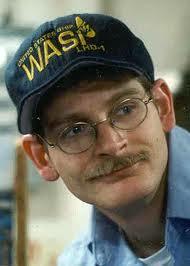USS Wasp's (LHD-1) Michael Noeth

Navy Draftsman Second Class Michael Noeth is my friend. Like other great people, he’ll somewhere cringe at my high thoughts and words of him. Most of us come across truth as it appears before us like a highway car accident. We’d like to know the realities but shield our squinting eyes so we can close them faster if the horrors are overwhelming. Michael, the brilliant artist, dove fearlessly into these moments believing the greatest human characteristics in the face of our inevitable fallibility could be found there.
A slight man, not very tall, but with expressive hands as if a drawing pencil or paintbrush were finishing a masterpiece at any moment, Michael moved about the USS Wasp (LHD-1) with purpose. Like other great men who perform the most admirable deeds, he elevated everyone around him. He could write the script of a Broadway play, train the actors, paint the background, and ensure the sound system recorded perfectly, only to write a review to make stars of the entertainers. He loved to ask the hard question, and witness the reluctant genuineness of an honest answer and constructive discourse. We are closer than we think to grasping and celebrating our own uniqueness.
After the Wasp’s cruise of 2000, Michael was provided the opportunity of his already impressive life. He was both commissioned and granted the creative license to draw WWII scenes and hoped to depict both Japanese and American soldiers with equal, but opposing, convictions. They were strong, determined, the best their respective societies had to throw at each other. They were deliberately drawn as barely old enough to qualify for war and appropriately terrified. Best-laid strategies only guaranteed the head-scratching randomness of death and every face revealed the invariable duality of war. As I left the ship in March of 2001, Michael had told me he had an upcoming art presentation at the Monserrat Art Gallery in New York City. I was so proud of him as he’d become famous for announcing the greatness of everyone but himself with such talent and humility.
Michael walked through the doors of the Pentagon on September 11th, 2001, like any other morning, looking forward to a day of work. He was producing portraits of those of us in the service who toil in obscurity, always believing our plight should be advertised on the highest stage. Michael was murdered by five hijackers on American Airlines Flight 77 when they crashed into the Pentagon in Arlington, Virginia, at 9:37 am.
In Life in Letters, John Steinbeck wrote: "When such a hopeless muddled need occurs, it does seem to me that the hungry hearts of men distill their best and truest essence, and that essence becomes a man, and that man a hero so that all men can be assured that such things are possible." Steinbeck was right about men like Michael Noeth. Mournfully, my friend Michael, this time I have the last word.


